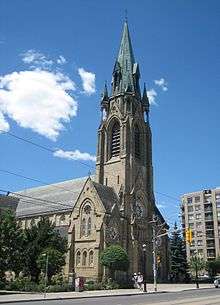St. Mary's Church, Toronto
| St. Mary's Church | |
|---|---|
 | |
| 43°38′43″N 79°24′13″W / 43.645143°N 79.403488°W | |
| Location | Niagara, Toronto |
| Country | Canada |
| Denomination | Roman Catholic |
| History | |
| Founded | 1852 |
| Administration | |
| Diocese | Archdiocese of Toronto |
| Clergy | |
| Pastor(s) | Rev Fernando Couto |
St. Mary's Church is a Roman Catholic church located at 130 Bathurst Street at Portugal Square in the Niagara neighbourhood of Toronto's west end. The parish was established by Irish immigrants in 1852. The Gothic Revival church was designed by Joseph Connolly and completed in 1889, with the tower finished in 1905. It stands as the picturesque western view terminus for Adelaide Street.
The rectory, convent and a school are also located along Portugal Square.
History
St. Mary's Church was built at McDonnell Square (now Portugal Square), which was one of several squares laid out in Toronto's 1834 'New Town Extension' plan such as Victoria Square, Clarence Square, and West Market Square. The cornerstone was laid on 15 August 1881 and the dedication took place on 17 February 1889, but the spire was not completed until 1905.[1]
In late September, 2012, workers discovered the church had been built atop at least one mass grave. Press reports indicate the graves are of those who died in cholera outbreaks in 1832 and '34. The church said it would dedicate an appropriate monument to the dead.[2]
Architect Joseph Connolly designed a building that was contemporary yet evoked Irish Roman Catholic church building traditions, which was important to the Irish priest and his predominantly Irish congregation at the time.[3]
St. Mary Catholic School was founded with the parish in 1852 and was originally operated by the Sisters of St. Joseph and the Christian Brothers. When the school outgrew the original structure on Adelaide Street, a new building was erected in 1918 facing McDonnell Square. This building was expanded in 1972. Currently, it is administrated by the Toronto Catholic District School Board, teaching Kindergarten through grade eight students.
Over time, large numbers of Poles and Ukrainians began to settle in the neighborhood around St. Mary's. By 1960, there was a large Portuguese population and McDonnell Square was renamed Portugal Square, with a part of Adelaide Street surrounding the block renamed Portugal Square to reflect the change.[4]
Some music has been recorded in the church such as jazz, pop, and classical. Trumpeter Kenny Wheeler used St. Mary's to record his record Ensemble Fusionaire for CBC in 1976 with four other fellow Canadian musicians.
Architecture
Joseph Connolly composed a three-aiselled basilica plan for the brick Gothic Revival design of St. Mary's Church, with a polygonal apsidal sanctuary, transepts slightly lower than the nave, and a morning chapel to the liturgical north or geographic south.[5] The tower is positioned in the centre of the main facade facing Bathurst Street. Side portals and windows are enclosed within a large arch.
The main facade features a central section at the base of the tower with a rose window framed by a moulded pointed arch on columns and capitals, with recessed roundels located around the window. Smaller and lower versions of this design symmetrically frame the middle section on both sides. Beneath the central rose window is a blind arcade, and the main doorway below is topped with a gable with two roundels on either side. The brick- and copper-clad spire is characterized by corner niches, with gables rising above belfry openings between the angle turrets.[6] The church's architecture aligns symmetrically with Adelaide Street with the tower facing the centre of the street, thus serving as a picturesque view terminus. Connolly's Church of Our Lady Immaculate in Guelph, Ontario stands similarly at the head of that city's Macdonell Street.
Arches to the transepts are carried on piers inside, and acanthus capitals crown the stone columns of the main arcades. The vaulted apse has a series of small stained-glass windows and paintings. The altar is wide, and the church has a small reredos with statues of Jesus and the Blessed Virgin Mary.
References
- ↑ Thurlby, Malcolm (May 2004). "Two Late Nineteenth-century Roman Catholic Churches in Toronto by Joseph Connolly: St Mary's, Bathurst Street and St Paul's, Power Street" (PDF). Ecclesiology Today (33): 33. Retrieved 2010-12-16.
- ↑ Graphic: End Zones — Finding out where Toronto has laid its dead, by David Topping, Jonathan Riviat, Andrew Barr, 17 January 2014, National Post
- ↑ Thurlby, Malcolm (May 2004). "Two Late Nineteenth-century Roman Catholic Churches in Toronto by Joseph Connolly: St Mary's, Bathurst Street and St Paul's, Power Street" (PDF). Ecclesiology Today (33): 38. Retrieved 2010-12-16.
- ↑ "St. Mary Catholic School". Toronto Catholic District School Board. Retrieved 2010-12-16.
- ↑ Thurlby, Malcolm (May 2004). "Two Late Nineteenth-century Roman Catholic Churches in Toronto by Joseph Connolly: St Mary's, Bathurst Street and St Paul's, Power Street" (PDF). Ecclesiology Today (33): 33. Retrieved 2010-12-16.
- ↑ Thurlby, Malcolm (May 2004). "Two Late Nineteenth-century Roman Catholic Churches in Toronto by Joseph Connolly: St Mary's, Bathurst Street and St Paul's, Power Street" (PDF). Ecclesiology Today (33): 34. Retrieved 2010-12-16.
See also
| Wikimedia Commons has media related to St. Mary's Church. |